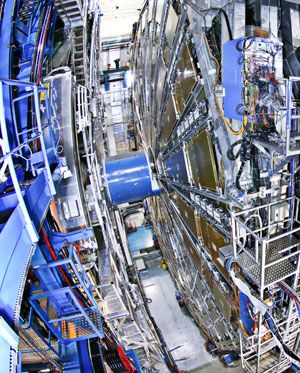
Later this spring, scientists at CERN, the European Organization for Nuclear Research, will restart the world’s biggest particle physics experiment, after a hiatus of two years. Beams of protons are scheduled to start circulating through the Large Hadron Collider (LHC) in mid-March. Physicists hope to start smashing the protons together and recording data before midyear.
When it restarts, the LHC will be able to smash protons with nearly twice the energy it had before. Even at its previous power level researchers were able to use the LHC to find the Higgs boson. This particle—whose existence was predicted decades ago—explains why some particles have mass. But scientists hope that the higher-energy collisions will reveal some new (if more difficult to explain) discoveries, such as the elusive supersymmetric particles or even possible candidates for dark matter, the mysterious material that binds the universe together.
The LHC got off to an inauspicious start, and that bad beginning explains some upgrades. In September 2008 during a final commissioning phase—and before the accelerator reached its planned maximum energy of 14 teraelectron volts—one of the more than 10,000 interconnections for wires supplying power to the superconducting magnets of the LHC failed, causing an arc that melted through a helium line and damaged a several-hundred-meter stretch of the system. After a year of repairs, the LHC started up and eventually reached a reduced collision energy of 7 TeV.

The upgrade being finished now is to reach 13 TeV. And it was clear from the beginning that it would require a complete overhaul of the interconnections. So CERN management decided to shut down the accelerator for a two-year period, starting in early 2013. This allowed the LHC engineering teams to update and upgrade several other systems, including the data gathering and storage technology and thecryogenics, which keep the system’s superconducting magnets at a crisp 1.9 kelvins. Also, the Atlas detector—one of four enormous machines in which the actual particle collisions take place—was equipped with an extra layer of particle detectors, increasing its precision substantially.
-
Tougher Interconnections
A team of about 280 technicians undertook the checking and reinforcing of more than 10,000 interconnections that connect the Large Hadron Collider’s superconducting wires. These cables, which have a trapezoidal cross section, are overlapped for several centimeters, pressed tightly together, and held in place with a silver-based solder. At full operation, the splices can carry a current of 13 kiloamperes, and the slightest fault would cause the junction to heat and fail.
The revision of the connections has now been completed, reports Jean-Philippe Tock, who leads the project. All junctions have been tested at room temperature. Those displaying anomalies were resoldered. All junctions have also been equipped with copper shunts, which can take over in case of failure, he says. The system that keeps watch on the new junctions has also been upgraded to provide better accuracy and resolution. “We have many more measuring points,” says Tock. For example, voltage surges that occur over groups of connections, which normally have a resistance of less than 3 nano-ohms, will automatically shut down the accelerator. “We have not invented new technology; we have applied existing technology to a very high level of quality and quality assurance to an unprecedented level,” he says.
-
Safer Cooling
When an electrical interconnection between two helium-cooled magnets failed in 2008—knocking askew accelerator magnets and damaging about half a kilometer of the 27-kilometer machine in a flood of coolant—the system lost a much larger quantity of helium than was expected.
“In response to this incident, we increased the number of safety valves on our vacuum systems, so that we do not get this avalanche of helium pressure that caused the displacement of magnets,” says Laurent Jean Tavian, leader of the cryogenic group at CERN’s technology department.
-
Bigger Data
“The data acquisition and storage system has been overdesigned from the beginning. We would have needed much more data than anticipated to run into problems,” says Niko Neufeld, who is responsible for the upgrade of high-speed data acquisition for LHCb. (LHCb is short for the LHC Beauty Experiment, which seeks to detect b [beauty] quarks and anti-b quarks; a difference in their decay rates would explain the matter-antimatter asymmetry in the universe.) Nevertheless, he and his colleagues have been upgrading data systems by replacing obsolete hardware with more efficient and compact modern systems. In the past CERN has developed and pioneered new hardware itself—the CAMAC (computer automated measurement and control) industrial data-acquisition standard and capacitive touch screens are examples. Although CERN now makes fewer custom systems, Neufeld says there is a need for specialized high-speed, radiation-hardened electronics that can operate in strong magnetic fields. And a bigger upgrade is in the works. For experiments scheduled to start in 2019, the data flow is expected to increase by two orders of magnitude. “This will require a significant change, and new technologies will have to be put in,” says Neufeld.
-
Superior Sensors
The Atlas detector is one of four placed around the few points where the counter rotating protons collide head-on. Beniamino Di Girolamo, the technical coordinator of the Atlas experiment, says that workers had to replace a layer of detectors, or “pixels,” that were close to the beam pipe because of radiation damage. However, such a replacement proved impossible because of structural constraints in the detector, so they decided to build an insert, called the IBL (insertable B layer) that would fit between the beam pipe and the innermost layer of the detector assembly. The IBL was then able to take advantage of better radiation- hard detector pixels, which were developed by a research program at CERN. But the most important aspect of the IBL is that it improves the precision of Atlas. “Having a layer at the beginning of a [particle] track is very important to us. If you have high precision very near the start of the track, then you can even relax the precision you need in the outer layers [of the detector assembly],” says Di Girolamo.
He reports that the insertion of the IBL, which was a very delicate operation, was successful. “The IBL, for its operation, has been cooled down and is now fully working,” he says.






